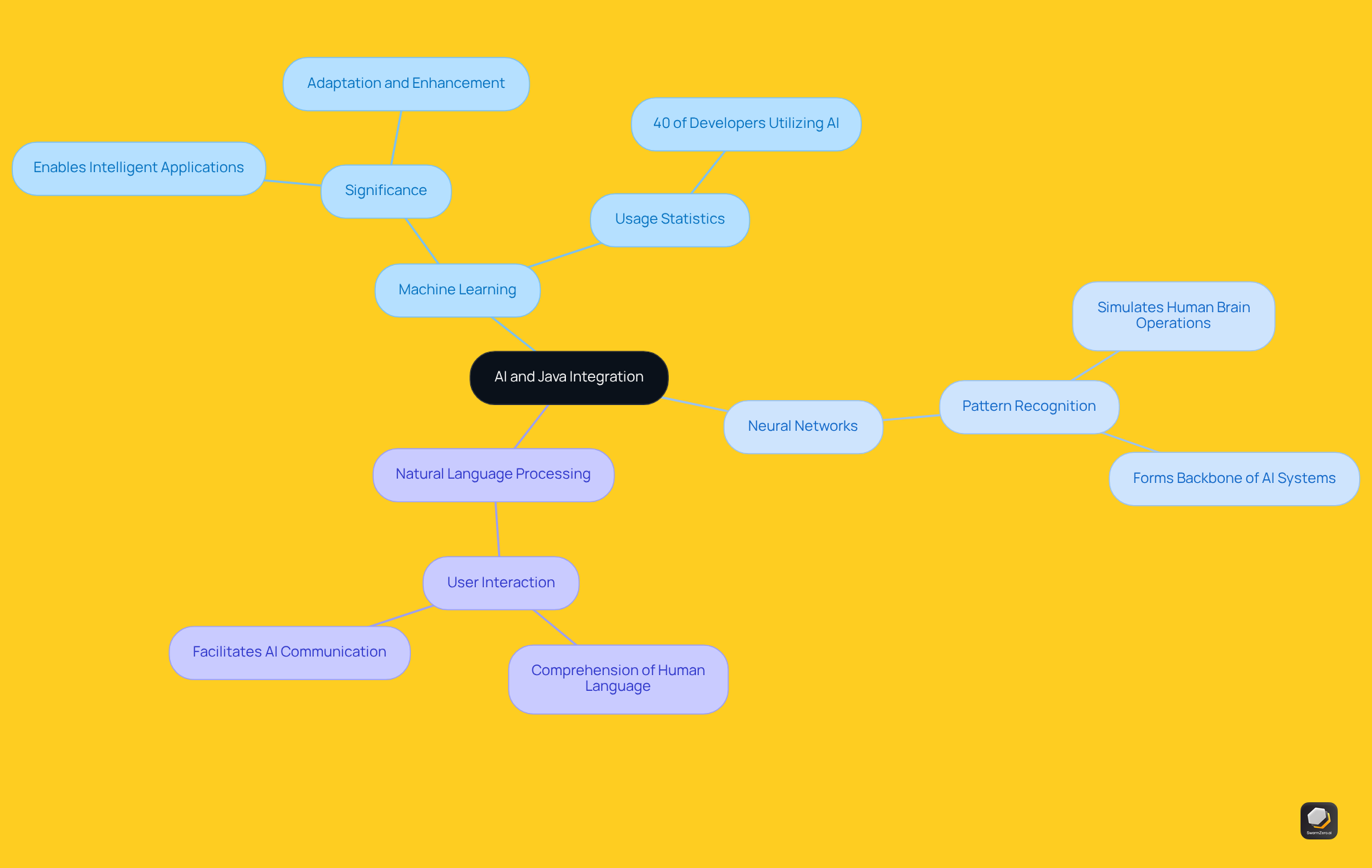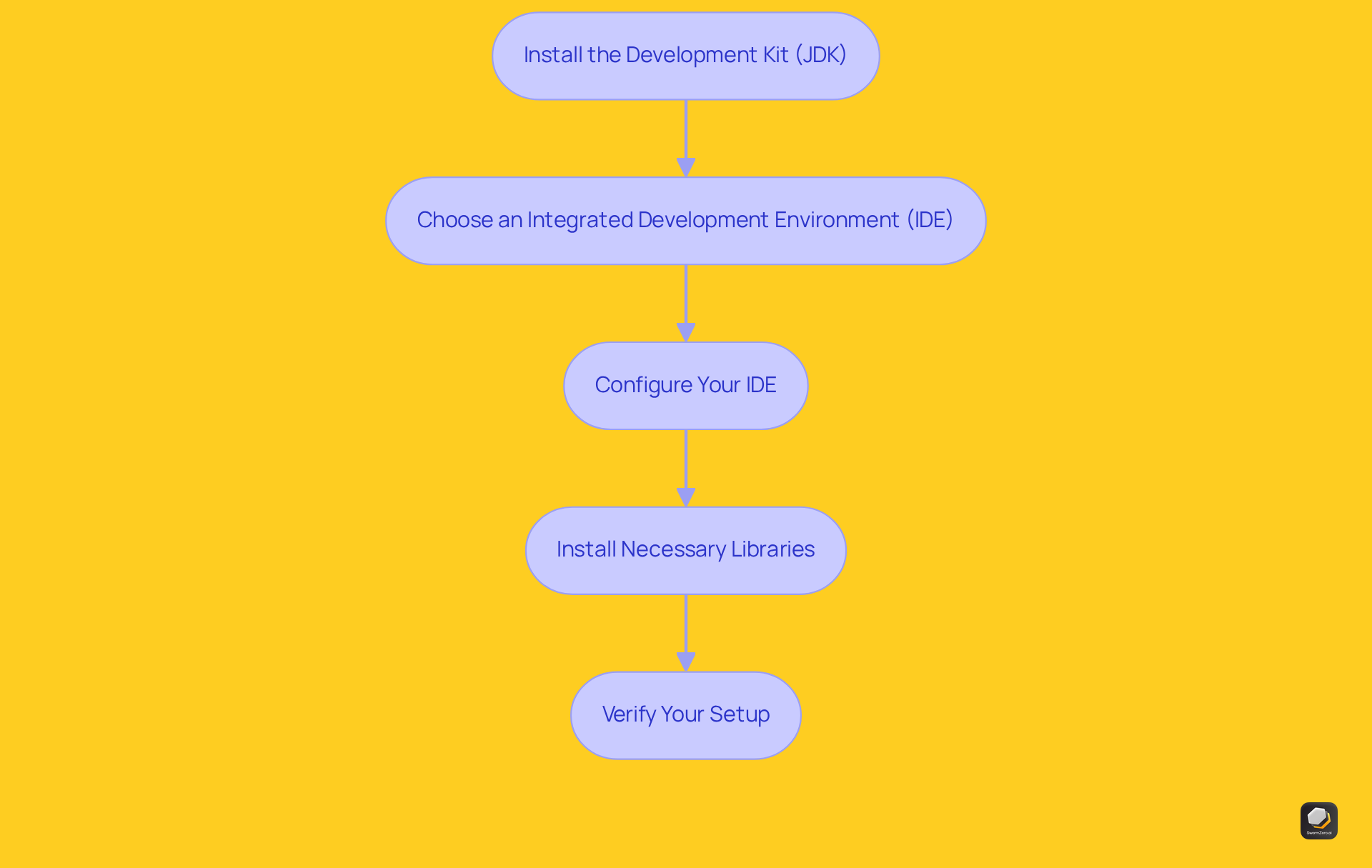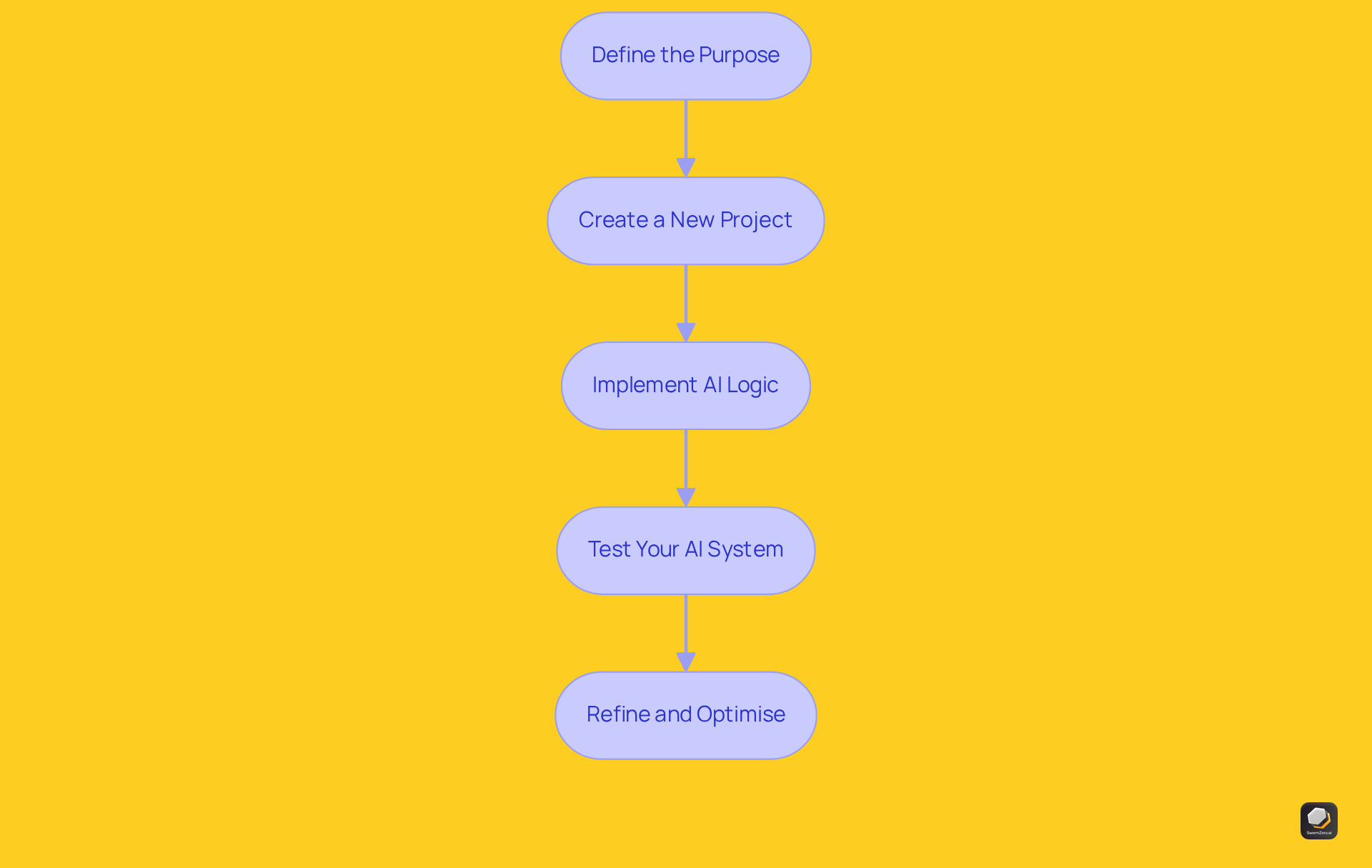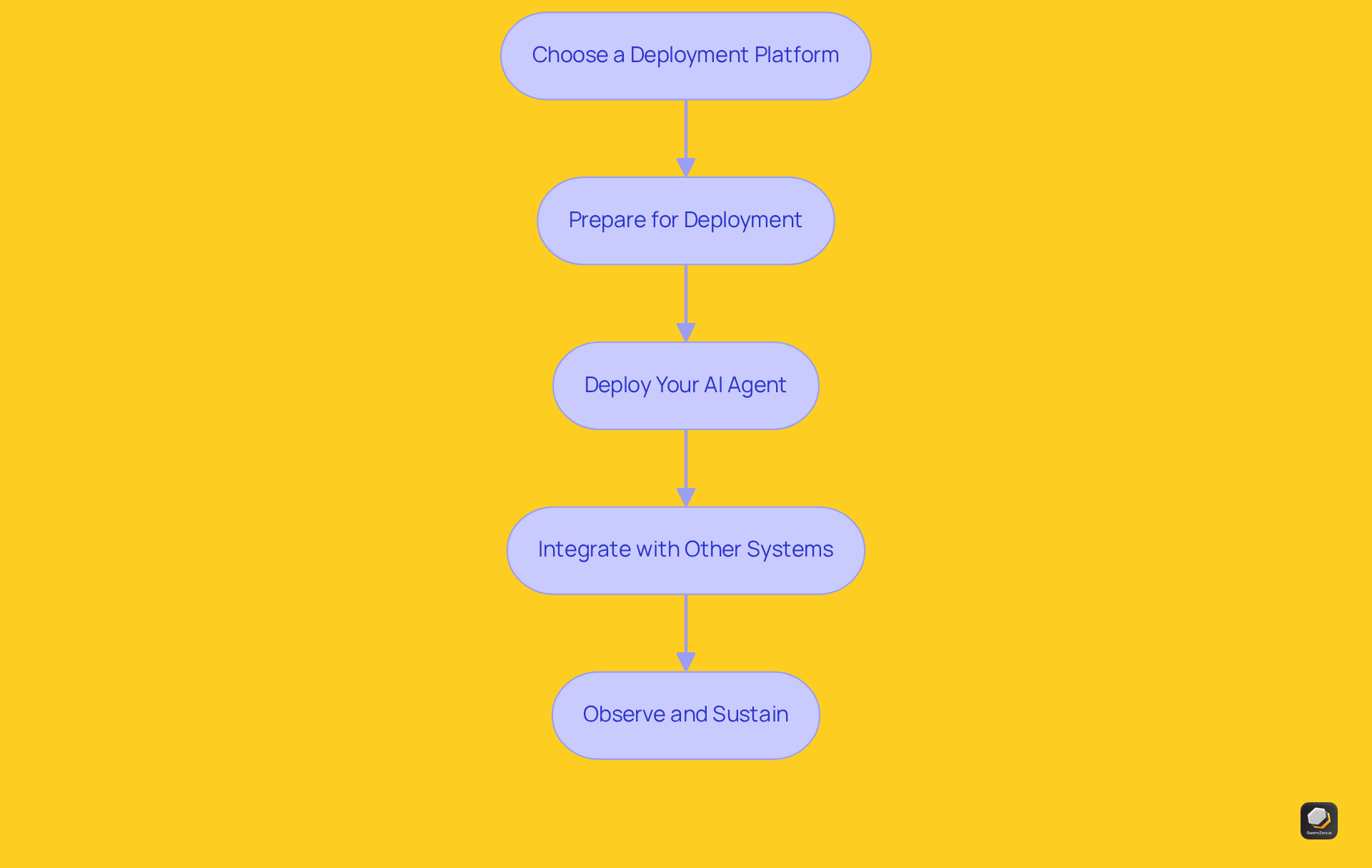4 Steps on How to Create an AI in Java
Learn the essential steps on how to create an AI in Java, from setup to deployment.

Key Highlights:
- Understanding AI concepts like machine learning, neural networks, and natural language processing is crucial for AI development in Java.
- Java's object-oriented nature and extensive libraries make it suitable for AI applications, with significant adoption among developers.
- Setting up a Java development environment involves installing the JDK, choosing an IDE, and configuring necessary libraries.
- Creating an AI in Java requires defining its purpose, implementing logic, testing, and refining the system based on user feedback.
- Deployment of AI agents can be done on cloud platforms like AWS, Azure, or Google Cloud, with a focus on packaging and integration with other systems.
- Continuous monitoring and updates post-deployment are essential for improving AI system performance and user satisfaction.
Introduction
Grasping the intricacies of artificial intelligence (AI) development in Java unlocks a realm of opportunities for programmers eager to innovate. Java's robust ecosystem and extensive libraries position it as a premier choice for crafting intelligent applications capable of learning and adapting. Yet, the transition from concept to execution can be formidable.
What essential steps must one take to successfully integrate AI into Java projects? This guide clarifies the process, outlining a definitive path to building, deploying, and refining AI agents, thereby equipping developers to navigate this cutting-edge technology with confidence.
Understand the Basics of AI and Java Integration
To effectively develop an AI in a programming language, grasping the fundamental concepts of artificial intelligence and their implementation is crucial. AI encompasses systems designed to perform tasks that typically require human intelligence, such as learning, reasoning, and problem-solving. The object-oriented nature and robust ecosystem of this programming language make it an ideal choice for AI development, supported by a wealth of libraries and frameworks, as well as seamless integration with cloud providers like AWS, Azure, and Google Cloud.
Key concepts to understand include:
- Machine Learning: This subset of AI focuses on algorithms that enable computers to learn from data and make predictions. In 2025, around 40% of developers indicated utilising a programming language for AI purposes, underscoring its significance in this field.
- Neural Networks: These algorithms simulate human brain operations to identify patterns and relationships within data, forming the backbone of many AI systems.
- Natural Language Processing (NLP): This field allows machines to comprehend and interpret human language, facilitating interactions between users and AI systems.
The significance of machine learning in AI development cannot be overstated; it enables developers to create intelligent applications that adapt and enhance over time. Successful AI projects that illustrate how to create an ai in java and employ machine learning have shown remarkable progress across various sectors, from finance to healthcare, highlighting the language's adaptability and efficiency in fostering innovation. As Mike Loukides, Vice President of Content Strategy at O'Reilly, observes, "While the programming language remains a foundational element for enterprise and mobile development, the industry's attention has moved toward AI, machine learning, and tools that enhance productivity."
Familiarising yourself with these concepts will provide a solid foundation for learning how to create an ai in java. Furthermore, utilising platforms such as SwarmZero, which provides an intuitive Builder for creating customised AI entities through the Tavily API, can greatly improve productivity and lower operational expenses via automation. This integration allows for the development of sophisticated AI-powered web search agents, making SwarmZero a comprehensive marketplace for building, monetising, and automating business solutions. Specific features of the SwarmZero framework, such as its user-friendly interface and robust support for various AI functionalities, further streamline the development process, ensuring that developers can efficiently create and deploy their AI applications.

Set Up Your Java Development Environment
Configuring your development environment is crucial when learning how to create an AI in Java. Follow these steps:
-
Install the Development Kit (JDK): Download the latest version of the JDK from the official Oracle website or adopt OpenJDK. Ensure that you set the JAVA_HOME environment variable correctly.
-
Choose an Integrated Development Environment (IDE): Popular choices include IntelliJ IDEA, Eclipse, and NetBeans. Download and install your preferred IDE.
-
Configure Your IDE: Set up your IDE to recognize the JDK. This usually involves specifying the JDK path in the IDE settings.
-
Install Necessary Libraries: Depending on your AI project, you may need libraries such as Deeplearning4j, Weka, or Apache OpenNLP. Use Maven or Gradle to manage these dependencies efficiently.
-
This point outlines how to create an AI in Java. Verify your setup by understanding how to create an AI in Java with a simple program to ensure everything is working correctly. Compile and run it to confirm that your environment is set up properly.

Build Your First AI Agent in Java
With your environment now established, it's time to explore how to create an AI in Java for your first AI entity. Follow these essential steps:
- Define the Purpose of Your AI System: Begin by determining the specific task your AI assistant will perform. This could range from a chatbot designed to address customer queries to an AI-powered web search agent leveraging the Tavily API within the SwarmZero framework. As Marcus Hellberg, VP of Developer Relations at Vaadin, aptly notes, "Incorporating AI into your programming applications doesn't have to be daunting."
- Create a New Programming Project: Within your IDE, initiate a new programming project and establish the necessary package structure.
- Implement the AI Logic: Develop the Java code that will define the behaviour of your AI entity. For example, if you're creating a chatbot, consider utilising NLP libraries to process user input and generate appropriate responses. Current trends indicate a 30-50% shift in AI engineering efforts towards the development of AI systems, underscoring the importance of this advancement. The SwarmZero framework can significantly enhance your system's capabilities, particularly when integrated with the Tavily API for advanced web search functionalities.
- Test Your AI System: Execute your project and interact with your AI assistant to verify that it operates as intended. Address any issues that may arise during testing.
- Refine and Optimise: Following your testing, refine the logic and boost the performance of your AI system. Consider incorporating features that allow the system to learn from interactions, thereby improving its responses over time. This iterative process is crucial for developing efficient AI systems that meet user needs.
By following these steps, you will understand how to create an AI in Java that is robust and capable of adapting and evolving based on user feedback. Additionally, referencing the SwarmZero AI Marketplace case study can highlight the practical applications and benefits of AI systems, reinforcing the importance of the procedures outlined in this guide.

Deploy and Integrate Your AI Agent
Once your AI system is built and tested, deploying and integrating it into your desired environment becomes essential. Follow these steps:
-
Choose a Deployment Platform: Select a suitable deployment environment for your AI agent. Options include cloud platforms such as AWS, Azure, or Google Cloud, which are increasingly popular due to their scalability and flexibility, or on-premises servers for more controlled environments.
-
Prepare for Deployment: When learning how to create an ai in java, package your software into a deployable format, such as a JAR file, ensuring that all dependencies are included. This step is vital for smooth deployment and operation.
-
Deploy Your AI Agent: Upload your packaged software to the chosen platform, adhering to the specific guidelines provided by the platform for deployment. This process may vary depending on the selected environment.
-
Integrate with Other Systems: If your AI assistant needs to interact with other applications, such as a CRM system, set up the necessary APIs to facilitate communication. Successful integration of Java AI programmes with CRM systems can significantly enhance our understanding of how to create an ai in java for improved operational efficiency. For instance, companies like Infosys have effectively utilised AI tools to streamline processes in finance management and demand forecasting.
-
Observe and Sustain: After deployment, continuously track your AI system's performance and interactions with individuals. Be prepared to implement updates and enhancements based on user feedback and changing requirements, as this will improve the effectiveness of the representative and user satisfaction.
In 2025, consulting firms estimate that over 50% of businesses are expected to deploy AI agents, reflecting the growing reliance on AI technologies to streamline operations and improve efficiency. Industry leaders emphasise the importance of choosing robust cloud platforms for AI deployment, as they provide the necessary infrastructure and support for successful integration. As Janakiram MSV noted, "Google’s announcements at Cloud Next 2025 represent a strategic, full-stack commitment to an AI-driven future centred on enabling and orchestrating agentic AI systems.

Conclusion
Creating an AI in Java demands a structured approach that intricately weaves together a deep understanding of core AI concepts with practical programming skills. This guide underscores the necessity of mastering both artificial intelligence fundamentals and Java integration techniques to effectively develop sophisticated AI applications.
Key steps encompass:
- Establishing a robust Java development environment
- Constructing your first AI agent
- Deploying the system in an appropriate setting
A firm grasp of machine learning, neural networks, and natural language processing is vital, alongside configuring your IDE and libraries to streamline the development process. The incorporation of platforms like SwarmZero can significantly amplify the capabilities of your AI projects, facilitating seamless deployment and interaction with other systems.
As reliance on AI technologies escalates, it becomes imperative for developers to remain informed and adapt to the ever-evolving tools and practises. Embracing these steps not only fosters innovation but also positions developers to meet the surging demand for intelligent applications across diverse sectors. The journey of creating an AI in Java transcends mere coding; it embodies the pursuit of leveraging technology to address real-world problems and enhance operational efficiency.
Frequently Asked Questions
What is the importance of understanding AI and Java integration for developers?
Understanding AI and Java integration is crucial for developers as it allows them to effectively develop AI applications by grasping fundamental concepts of artificial intelligence and their implementation in Java, which is an ideal programming language for AI development.
What are the key concepts of artificial intelligence that developers should know?
Key concepts include Machine Learning, which focuses on algorithms that enable computers to learn from data; Neural Networks, which simulate human brain operations to identify patterns; and Natural Language Processing (NLP), which allows machines to comprehend and interpret human language.
How significant is machine learning in AI development?
Machine learning is highly significant in AI development as it enables developers to create intelligent applications that adapt and enhance over time, making it a foundational element in the field.
What are some successful applications of AI in various sectors?
Successful AI projects have been implemented across various sectors, including finance and healthcare, showcasing the adaptability and efficiency of Java in fostering innovation.
What is the role of platforms like SwarmZero in AI development?
Platforms like SwarmZero provide tools for creating customised AI entities through the Tavily API, improving productivity and lowering operational expenses via automation, and allowing for the development of sophisticated AI-powered web search agents.
What features does the SwarmZero framework offer to developers?
The SwarmZero framework offers a user-friendly interface and robust support for various AI functionalities, streamlining the development process and enabling efficient creation and deployment of AI applications.
List of Sources
- Understand the Basics of AI and Java Integration
- Java Trends 2025: Innovations Shaping the Future of Development | Reverside (https://reverside.co/2025/03/27/java-trends-2025-innovations-shaping-the-future-of-development)
- Java Trends Signal a Shift in Developer Learning Amid AI Surge -- ADTmag (https://adtmag.com/Articles/2025/01/07/Java-Trends-Signal-a-Shift.aspx)
- Introducing Embabel: Advanced AI Agent Development for Java Applications (https://infoq.com/news/2025/06/introducing-embabel-ai-agent)
- Evolution of Java Ecosystem for Integrating AI (https://inside.java/2025/01/29/evolution-of-java-ecosystem-for-integrating-ai)
- Set Up Your Java Development Environment
- Top AI Development Tools for Java in 2025 | Kenility (https://kenility.com/blog/ai-tech-innovations/ai-development)
- 15 Best AI Tools for Java Programming (Coding) in 2025 | SaM Solutions (https://sam-solutions.com/blog/ai-tools-for-java-developers)
- The Top Java Development Environments for 2024 | Techreviewer Blog (https://techreviewer.co/blog/the-top-java-development-environments)
- Top 15 Best Java IDE (2025) That Every Developer Must Know! // Unstop (https://unstop.com/blog/best-java-ide)
- Build Your First AI Agent in Java
- Building a custom AI agent in Java: A hands-on guide | Vaadin (https://vaadin.com/blog/building-a-custom-ai-agent-in-java-a-hands-on-guide)
- Introducing Embabel: Advanced AI Agent Development for Java Applications (https://infoq.com/news/2025/06/introducing-embabel-ai-agent)
- Meet Embabel: A Framework for Building AI Agents With Java (https://thenewstack.io/meet-embabel-a-framework-for-building-ai-agents-with-java)
- Building AI Agents with Google Agent Development Kit (ADK), Java and MCP Tools : Build a learning… (https://medium.com/javarevisited/building-ai-agents-with-google-agent-development-kit-adk-java-and-mcp-tools-build-a-learning-0acc29a4e1cb)
- Build AI Apps and Agents in Java: Hands-On with LangChain4j - JAVAPRO International (https://javapro.io/2025/04/23/build-ai-apps-and-agents-in-java-hands-on-with-langchain4j)
- Deploy and Integrate Your AI Agent
- Building business applications with Google Cloud’s AI Agent tools (https://revolgy.com/insights/blog/building-business-applications-with-google-cloud-ai-agent-tools)
- DigitalOcean Launches AI Platform to Simplify Deployment of Generative AI Agents -- ADTmag (https://adtmag.com/articles/2025/01/22/digitalocean-launches-ai-platform-to-simplify-deployment-of-generative-ai-agents.aspx)
- Google Unveils The Most Comprehensive Agent Strategy At Cloud Next 2025 (https://forbes.com/sites/janakirammsv/2025/04/14/google-unveils-the-most-comprehensive-agent-strategy-at-cloud-next-2025)
- Google Cloud Unveils Multi-Agent Capabilities in Vertex AI (https://maginative.com/article/google-cloud-unveils-multi-agent-capabilities-in-vertex-ai)




